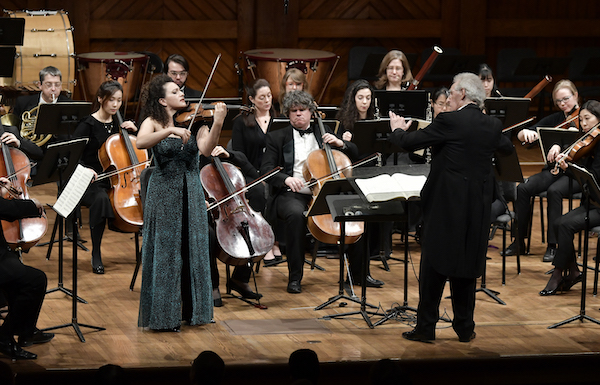Concert Review: Boston Philharmonic plays Beethoven and Rachmaninoff

Violinist Liza Ferschtman and the Boston Philharmonic Orchestra’s account of Beethoven’s Violin Concerto lacked nothing for momentum and spirit.
Violinist Liza Ferschtman made her local debut Thursday night at Sanders Theater playing Beethoven’s Violin Concerto with the Boston Philharmonic Orchestra (BPO). Given the ensemble’s frequent advertisements of her appearance these last couple of weeks, this was a run-through of the warhorse that carried with it a bit of anticipation. And it lived up to those heightened expectations.
Ferschtman is a violinist with unimpeachable technique and a compelling stage presence. Her tone is silvery and pure. In Thursday’s performance, her playing was consistently poetic, whether in the Concerto’s delicate, exposed textures or in its hearty, rustic gestures. She exhibited a natural sense of the music’s character and even managed to capture that most exotic of its qualities: the score’s sense of playfulness and, yes, fun (which is too often lost in the serious, overly reverent performances the piece often gets).
Certainly, it helped that she had Benjamin Zander for her interpretive partner. Zander’s approach to Beethoven is consistently refreshing, combining brisk tempos, a close attention to structural and dynamic shape, as well as lean textures – all of which tend to result in readings that strip away the traditional detritus that accumulates around canonic favorites like this Concerto.
Indeed, Thursday’s account of the piece lacked nothing for momentum and spirit. The big first movement offered plenty of vigor – the opening low-string articulations, for instance, were biting – as well as grandeur and sweep. In the second, the music’s ethereal spots shimmered but never dawdled. And the finale danced jauntily.
Ferschtman’s take on the solo line called to mind Christian Tetzlaff’s mesmeric approach to the same work with the BSO from 2015. She approached the musical line with a mix of flexibility and rigor. The first movement’s arpeggiated runs were shapely and improvisatory-sounding, but consistently warm-toned. In the second movement, the floating, stratospheric opening solo figures married a breathtaking lightness of touch with rhythmic precision. And the finale was a nimble, cleanly executed romp.
Both outer-movement cadenzas, too, were played with zest. Ferschtman and BPO timpanist Edward Meltzer gave a riotously spunky take of the first-movement one (which Beethoven wrote for his keyboard adaptation of the Concerto), while Ferschtman lit into Fritz Kreisler’s familiar third-movement showcase furiously (her encore was more Kreisler: his Recitative & Scherzo Caprice).
Zander and the BPO provided an accompaniment that neatly matched the expressivity and color of Ferschtman’s playing. Antiphonally-seated violin sections brought a winning degree of textural clarity to the proceedings (especially in the first movement), while the orchestra’s woodwind section glowed in the second movement. Principal bassoon Lisa Chesholm’s droll third-movement solos added a further layer of bucolic charm to the reading.

After intermission came Rachmaninoff’s Symphonic Dances.
Written for the Philadelphia Orchestra in 1940, it’s Rachmaninoff’s last completed piece. The Dances sum up his career with a degree of instrumental brilliance that has rarely been matched, while also conveying a sense of melancholy that is as potent and touching as anything found in Mahler or Beethoven.
“Zander and the BPO realized the reflective facet of the music with a performance that was powerfully coherent, structurally; dazzling, ensemble-wise; and emotionally riveting, ably capturing the music’s mix of sadness, resignation, vigor, and joy.”
The first movement, highlighted by Philip Staudlin’s beguiling account of the saxophone solos, drove with dancing energy. There was a velvety warmth to the darkly lilting second-movement waltz that recalled the Philadelphia Orchestra’s famous luxurious sonority. And the finale brimmed with excitement, its rhythms taut, colors blazing, and dramatic trajectory perfectly focused.
Among the night’s numerous individual highlights were concertmaster Gregory Vitale’s second-movement solos and brief third-movement turns from principal flute Lisa Hennessy and principal clarinet Rane Moore. Additionally, Franziska Huhn made dulcet work of Rachmaninoff’s harp writing and pianist Rasa Vitkauskaite’s “accompaniment” of the sensuous first-movement strings’ melody gleamed.
 Jonathan Blumhofer - The Arts Fuse
Jonathan Blumhofer - The Arts Fuse